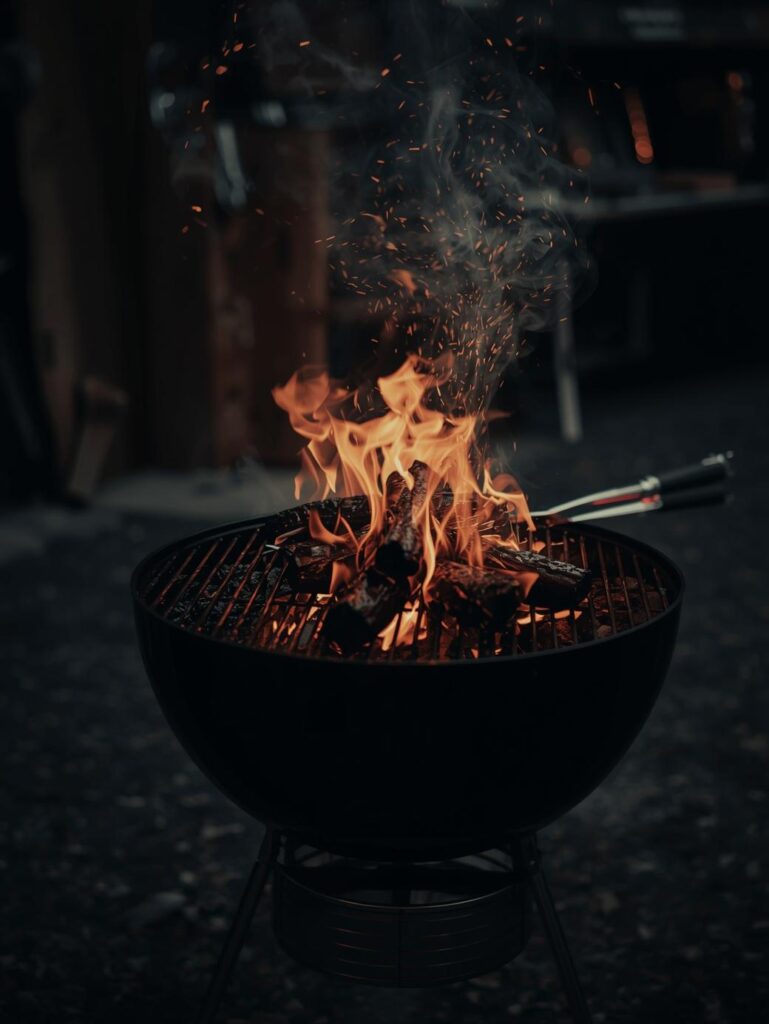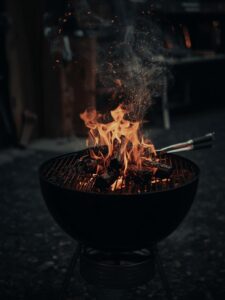Expert’s Note: This guide is part of our essential BBQ Equipment Maintenance Series. A proper winter plan protects your investment and ensures perfect performance.
WINTERIZING YOUR GRILL: STORAGE VS. COLD-WEATHER GRILLING
“The first frost presents a choice for the pitmaster: grant your grill a peaceful hibernation or forge it into a winter warrior. There is no wrong answer, only a decision that must be made with purpose and preparation.”
Winterizing Your Grill: Storage vs. Cold-Weather Grilling
Download our free Winter Grill Prep Checklist to ensure you don't miss a step.
As the vibrant colors of autumn fade to the stark grays of winter, a critical decision looms for every grill owner. Do you tuck your trusted companion safely away, protecting it from the harsh elements until spring? Or do you layer up, declare that “grilling season is never over,” and charge headfirst into the exhilarating challenge of cold-weather cooking?
This is the great winter divide. Both paths are valid, but both require a deliberate strategy. Choosing the middle ground—neglect—is the only true failure. Neglect leads to rusted burners, clogged orifices, and a frustrating springtime resurrection.
This definitive guide will lay out two clear, actionable plans. First, we will detail the meticulous process of winterizing your grill for storage, ensuring it emerges in spring as good as new. Second, for the intrepid all-weather pitmaster, we will provide the essential blueprint for adapting your grill and your techniques to conquer the cold. Your mission is to choose your path and execute it flawlessly.
❄️ THE CROSSROADS: UNDERSTANDING THE ENEMY
Before you choose, understand what winter throws at your grill. It’s more than just cold.
⚙️ The Winter Assault on Your Grill:
- Moisture & Corrosion: The constant cycle of snow, ice, and thawing is a grill’s worst nightmare. Moisture seeps into every seam, accelerating rust on burners, grates, and the interior firebox. Road salt aerosolized in the air can compound this corrosion dramatically.
- Thermal Stress: Rapid temperature swings—from a 500°F cook to sub-freezing air—can cause metal to contract and expand, potentially warping thin components or cracking porcelain coatings.
- Fuel Inefficiency: As covered in our Cold Weather Smoker Guide, propane and pellets burn less efficiently in the cold, and cold metal acts as a heat sink, sucking energy away from your food.
- Animal Intruders: A warm, sheltered grill is a five-star hotel for mice and insects looking to nest for the winter, often with disastrous results for your grill’s internals.
🛌 PATH ONE: THE DEEP SLEEP – COMPLETE WINTERIZATION FOR STORAGE
If you live in a region with relentless snow, ice, and sub-freezing temperatures, or simply prefer to take a break, this is your protocol. The goal is to create a clean, dry, and protected state for your grill.
🧼 Step 1: The Final, Thorough Cleaning
This is not your regular post-cook scrape. This is a deep, surgical clean to remove all food and grease that could attract pests or cause corrosion.
Action Plan: – Fire it up one last time to burn off loose debris. – After it cools, remove grates, flavorizer bars, and heat shields. – Soak and scrub all removable parts with a degreaser and a grill brush. – Scrape the interior firebox walls and vacuum out all ash and debris. – Critical: Clear the grease management system. A clogged grease tray is a magnet for pests and a fire hazard next season.
🛡️ Step 2: Protect & Disconnect
For Gas Grills: – Turn the gas off at the tank. – Disconnect the tank. Store it outdoors, upright, in a well-ventilated area, never in a garage or basement. – Cover the gas line inlet on the grill with a plastic bag and a rubber band to prevent insects from entering.
For Pellet Grills: – Vacuum out the entire fire pot and the interior of the cook chamber. – Run the grill until the hopper is empty of pellets to prevent moisture absorption and clumping. – Vacuum out the hopper.
📦 Step 3: Strategic Storage
Location: An unheated shed or garage is ideal. A covered patio is acceptable. Never store a propane tank indoors.
Covering: Use a high-quality, breathable, and waterproof grill cover. A vinyl tarp that doesn’t breathe can trap moisture underneath, promoting mold and rust—the very thing you’re trying to prevent.
Rodent Deterrence: Place a few dryer sheets or mothballs inside the grill (on the cleaned grates) and in the storage area; rodents hate the smell. Ensure all vents are covered with wire mesh.
Pro Tip: Before storing, apply a light coat of cooking oil to your cast iron or stainless steel grates to prevent rust during dormancy. For ceramic-coated grates, ensure they are perfectly dry.
🔥 PATH TWO: THE WINTER WARRIOR – GEARING UP FOR COLD-WEATHER GRILLING
You’ve chosen to fight. This path is about adaptation, optimization, and embracing the challenge.
🎒 The Winter Warrior’s Gear Kit
Your summer setup won’t cut it. You need to invest in a few key items.
1. The Welding Blanket: As detailed in our Cold Weather Smoker Care guide, this is your #1 weapon. Drape it over the lid and body of your gas or charcoal grill to drastically reduce heat loss and wind chill. Ensure it’s kept clear of hot vents.
2. A Heavy-Duty, Insulated Grill Cover: When not in use, a sturdy cover is essential to keep snow and ice off your grill, reducing pre-heat time.
3. A Reliable Probe Thermometer: With ambient temperatures fooling your senses and your grill’s lid thermometer, a dual-probe system (one for grill temp, one for meat temp) is non-negotiable for precision.
4. A Powerful Headlamp: It gets dark early. You need both hands free to manage grates, tools, and food in the winter gloom.
🎛️ Tactical Adjustments for Winter Cooking
Pre-heat Time: Double it. A 15-minute summer pre-heat becomes a 30-minute winter ritual. Your grill needs to fully heat-soak the cold metal.
Fuel Management: – Propane: Keep spare tanks. Cold propane doesn’t vaporize well, leading to low pressure. Store tanks indoors until use. – Pellets/Charcoal: Store fuel in a sealed, dry container. You will use 25-50% more fuel, so stock up.
The “Temperature Bump”: Plan to cook at a temperature 25°F higher than you would in summer to compensate for ambient heat loss.
Lid Discipline: This is the golden rule. Every lid flip releases a massive amount of heat. Plan your moves, use your probes, and keep it closed.
🧯 Winter Warrior Safety Protocol
The stakes are higher. Safety is paramount.
– Clear Your Battlefield: Keep the area around your grill free of snow and ice to prevent slips and falls with hot food.
– Check for Gas Leaks: Cold can cause rubber seals in gas connections to contract. Periodically check connections with a soapy water solution.
– Beware of Meltwater: Snow melting off a roof onto a hot grill can cause thermal shock and damage. Be mindful of your grill’s placement.
🎯 Winter Grill Strategy Matrix
| Consideration | The Storage Path | The Warrior Path |
|---|---|---|
| Ideal For | Harsh winters, infrequent users, those without covered space. | Year-round enthusiasts, those with some shelter, quick-weeknight cooks. |
| Primary Goal | Preservation & Protection | Optimization & Adaptation |
| Key Action | Deep Clean, Disconnect, Dry, and Cover. | Insulate (Welding Blanket), Increase Fuel, Adjust Temp. |
| Spring Outcome | A grill in like-new condition, ready for a quick start. | A grill that has been consistently used, requiring ongoing maintenance. |
🤔 THE HYBRID APPROACH: STRATEGIC STORAGE FOR THE OCCASIONAL WARRIOR
Perhaps you don’t grill weekly in winter, but you don’t want to fully pack it away for a single holiday steak. This hybrid model offers flexibility.
🔧 The “Ready Reserve” Protocol:
– Perform the Deep Clean as in Path One. A clean grill is a stable grill.
– Keep your Welting Blanket and Probe Thermometer readily accessible.
– Keep a small amount of fuel on hand (one propane tank, one bag of pellets).
– Keep the grill covered but not disconnected.
– When the craving hits, you’re only 30 minutes of pre-heat away from a perfect meal, without the commitment of full-season use or the risk of neglect.
🏁 CONCLUSION: MAKE YOUR CHOICE WITH CONFIDENCE
Winter does not have to be the end of your grilling journey, nor does it have to be a battle against the elements that wears down your equipment. The power is in your hands to choose the path that best suits your climate, your ambition, and your lifestyle.
The pitmaster who tucks their grill away with care is just as wise as the one who sears a steak in a snowstorm. Both have made a conscious decision to respect their craft and their tools. The only loss is in indecision—the slow, silent damage of neglect.
Your mission is this: Before the first major freeze, declare your intent. Will you be a curator or a conqueror? Whichever you choose, execute the plan laid out in this guide with precision. Your grill—and your future self—will thank you.
📚 Related BBQ Topics
- Cold Weather Smoker Care: The Ultimate Winter BBQ Guide – Deep dive into smoking in the cold.
- Gas Grill Troubleshooting: From Ignition to Temperature Issues – Fix common winter-related problems.
- BBQ Equipment Maintenance Series – The foundation of all grill care.
- Best Winter BBQ Recipes – Dishes built for the cold.
Your Grill’s Winter Fate Awaits
Don’t let winter decide for you. Take control with a proven plan for storage or all-season grilling.



